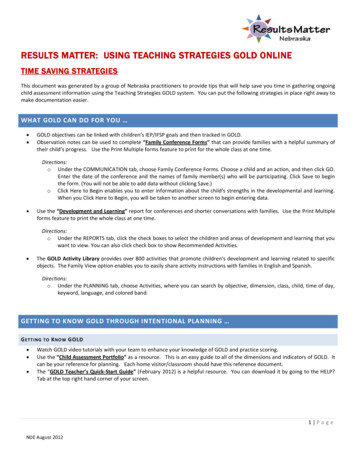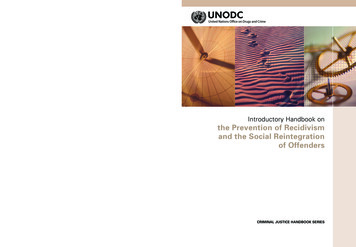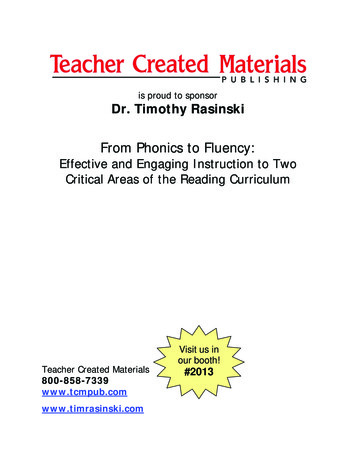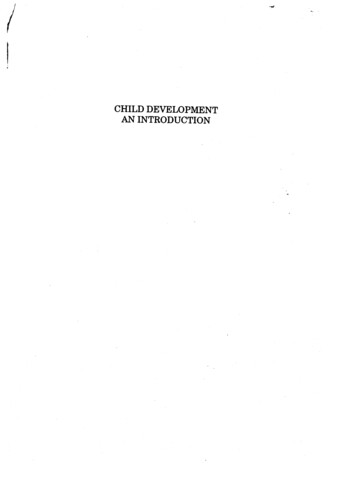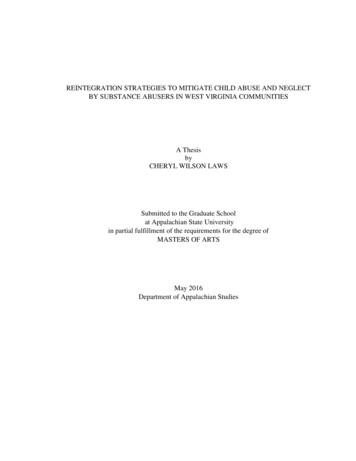
Transcription
REINTEGRATION STRATEGIES TO MITIGATE CHILD ABUSE AND NEGLECTBY SUBSTANCE ABUSERS IN WEST VIRGINIA COMMUNITIESA ThesisbyCHERYL WILSON LAWSSubmitted to the Graduate Schoolat Appalachian State Universityin partial fulfillment of the requirements for the degree ofMASTERS OF ARTSMay 2016Department of Appalachian Studies
REINTEGRATION STRATEGIES TO MITIGATE CHILD ABUSE AND NEGLECTBY SUBSTANCE ABUSERS IN WEST VIRGINIA COMMUNITIESA ThesisbyCHERYL WILSON LAWSMay 2016APPROVED BY:Dr. William SchumannChairperson, Thesis CommitteeDr. Sarah Beth HoptonMember, Thesis CommitteeDr. Michael PotterMember, Thesis CommitteeDr. William SchumannChairperson, Department of Appalachian StudiesMax C. Poole, Ph.D.Dean, Cratis D. Williams School of Graduate Studies
Copyright by Cheryl Wilson Laws 2016All Rights Reserved
AbstractREINTEGRATION STRATEGIES TO MITIGATE CHILD ABUSE AND NEGLECT BYSUBSTANCE ABUSERS IN WEST VIRGINIA COMMUNITIESCheryl Wilson LawsR.B.A., West Virginia State UniversityM.A., Appalachian State UniversityChairperson: Dr. William SchumannThis thesis evaluates the effectiveness of current intervention strategies employed byorganizations that provide socially necessary services (SNS) to Kanawha County, West Virginiaparents whose drug addictions pose an impending danger to the continued safety of their childrenand led to substantiated allegations of child abuse and neglect. These organizations, known asadministrative service organizations (ASO), are referred to these maltreating parents by ChildProtective Services (CPS) to control or mitigate impending dangers to the safety ofabused/neglected children posed by maltreating parents with drug addictions. The current modusoperandi of the state of West Virginia is to facilitate an intervention, provide treatment andreunify the family. However, there is an omitted and crucial piece to the sustainability of thefamily unit once they are released from the supervision of the state, which is in the form of acommunity reintegration strategy that will support the family’s success as a functioning socialunit upon release from the child welfare system. This thesis intends to show that without thisintegral piece of the circle, the cycle of drug abuse cannot be broken therefore fails at thesustainability of the sobriety of the maltreating parent as well as the family as a functioning unit.iv
DedicationThis work is dedicated to my son, Nicholas Gregory Laws, my daughter, Sydney JuliannAtkins and to my granddaughters, Jamesyn Audra and Emeri Rayne Laws. You are the reason Ido all that I do- to inspire you not only with my words, but by the example of the richness of mylife. May you know that it is never too late to follow your passion. Dream big, work hard andmake beautiful memories.I also dedicate this work to every parent who has ever lost custody of their child, for thechildren who miss them and to Stacy Dawn Parsons and other fallen angels this epidemic hastaken away long before they had the opportunity to recreate themselves and this world.“Unless someone like you cares a whole awful lot, nothing is going to get better. It’s not.”-Dr. Seussv
AcknowledgementsI would first like to thank Appalachian State University and the Center for AppalachianStudies for an incredible educational experience. To my Thesis Director, Dr. William Schumannfor his respect of my vision and his commitment to prepare and guide my research towards mygoal. I would also like to thank my Thesis Committee, Dr. Sarah Beth Hopton and Dr. MikePotter for their time and contributions to ensure my research was scholarly and professionallywritten.I would not be where I am today if it weren’t for the support of several of my familymembers. The trust, patience and devotion of my daughter, Sydney Atkins, her willingness totake this adventure with me to Boone, North Carolina and belief in my vision has given me thestrength to complete my degree and this research. I am also grateful for the love and support ofmy mother through both my undergraduate and Masters Degree and the time my sister, DenysSnodgrass, devoted to editing this thesis. A special thank you to Cat Talley from theAppalachian State University Writing Center for teaching me writing skills that will stay with methroughout my career and for her encouragement.I would also like to acknowledge my long-time friend and therapist, J.R. Keener, for hisguidance in teaching me to believe in myself, to trust my instincts and pursue only and all thingsthat enhance my life. Lastly, I would like to thank my friend, colleague and business partner, Dr.Sundjata ibn-Hyman for helping me create the story I have tried to tell within this thesis and forsharing my vision to keep children throughout West Virginia safe while an opportunity isprovided for substance abusers to reset and recreate a new life for themselves and their families.vi
Table of ContentsAbstract . .ivDedication . . .vAcknowledgements .viList of Figures .xChapter 1: Introduction to the Socioeconomics of Drug Addiction .1History of Drug Use . 1Susceptibility to Substance Abuse . .3Substance Abuse and the Demise of the Family Unit . 8Substance Abuse and the Maltreatment of Children .10Child Welfare System . 13Treatment Obstacles . .14Stress, Relapse and Re-Offending Maltreatment . 16Post-Treatment Hardships . 17Chapter Conclusion .19Chapter 2: Policy Context of West Virginia .20vii
Substance Abuse in West Virginia.21Child Protective Services Policy for Abuse and Neglect Referrals .24Child Protective Services Procedure for Abuse and Neglect Referrals .25Provision of Services for In-Home Safety Plans . .32Adjudication Process for Out-of-Home Safety Plans . .34Three Key Gaps within the Current System . 39Chapter Conclusion .45Chapter 3: Critical Engagement- Literature Reviews and Case Studies .46Community-Level Change . .46Literature Review 48Case Studies .53Chapter Conclusion .59Chapter 4: Methods of Research 61Research Introduction .61Research Process .61Data Samples. .64Survey Results .65Interview Results . 67viii
Analysis of Secondary Research .68Research Conclusion 76Chapter 5: Treatment, Prevention and Reintegration .78Treatment . .78Prevention . .82Reintegration . .85Healthy Kids and Families Coalition . 87Pollen8, Inc . .88Chapter Conclusion .94Chapter 6: Thesis Conclusion .95Thesis Overview . .96Further Research .97Long-Term Objectives . .98Challenges and Obstacles .100Final Thoughts . .101Indexes .106References . .114Vita .137ix
List of FiguresFigure 1- Child Protective Services (CPS) Procedure for Abuse and Neglect Referrals .29Figure 2- Child Protective Services (CPS) Adjudication Process for Out-of-HomePlacement .38Figure 3- Survey Question 3 .66x
Chapter 1: Introduction to the Socioeconomics of Drug AddictionChapter IntroductionThis chapter discusses the history of drug addiction, the role that drug addiction plays inthe demise of the family unit, how the socioeconomics stressors such as unemployment, classidentification and role ambiguity in low-income communities contribute to the propensity forrelapse in drug addicts and the effects that stress has not only on initial parenting roles, but alsoin exasperating the propensity for relapse and delay of recovery. Lastly, scholarly literature isutilized to build a theoretical framework, explaining the degrees to which children living withsubstance abusing parents are susceptible to danger and maltreatment.1Substance abuse is a significant health and social problem plaguing families throughoutthe United States. Substance abuse often occurs within an environment of emotional, social andeconomic deprivation that can include poverty, mental illness, domestic violence, economic, andhousing uncertainty, dangerous neighborhoods and stress, which are often correlated with higherincidences of maltreatment (Semidei, Radel, & Nolan, 2001; Orme & Rimmer, 1981; Walsh,MacMillan & Jamieson, 2003). Substance abuse has also been found to have a negative impacton family functioning (Bijur, Kurzon, Overpeck, & Scheidt, 1992; Kumpfer, 1987). Parentalsubstance abuse either directly or indirectly, places a child at higher risk of maltreatment andfamily life is more likely to deteriorate when parents abuse drugs.History of Drug UseJohann Hari (2015) spent 10 years researching his book, Chasing the Scream, to try andbetter understand the plague that had swept into the worlds of his loved ones. He wanted to1Maltreatment- cruel or violent treatment of a person; abuse.1
better comprehend not only addiction but the effects that prohibition (War on Drugs) has had onthe advancement and increase of drug usage within the United States and throughout the world.Also, his research sought to further identify the driving forces behind why certain people becomeseverely addicted to drugs and why others can use it recreationally and never become addicted(Hari, 2015).Hari (2015) states that humans have a history of wanting to alter the mind. There hasnever been a society in which humans didn’t seek to alter their mental capacities. In the Andesin 2000 B.C., people were smoking hallucinogenic herbs through pipes they made themselves.Ovid said drug induced ecstasy was a divine gift. The Chinese were cultivating opium by 700AD and hallucinogens and chemicals caused by burning cannabis were found in clay pipefragments from the home of William Shakespeare. Our founding president, George Washington,insisted that soldiers be given whiskey as part of their rations every day (Hari, 2015). Smallchildren instinctually are drawn to the sensation that is provided to them when they spinthemselves round and round in circles. The nausea this can cause isn’t even a deterrent from theeuphoric, dizzy feeling that happens within the brain. A physician, Andrew Weil expresses thatseeking this altered state must represent a basic human instinct, which enables Professor RobertSiegel to claim that the desire to alter our consciousness is the “fourth” drive in human minds, inconjunction with the desire to eat, drink, and have intercourse. He feels it is biologicallypredictable and provides humans with moments of freedom and reprieve (Hari, 2015).Hari (2015) further shares that only ten percent of drug users have a problem with theirsubstance of choice. Ninety percent are not harmed by it (United Nations Office on DrugControl, 2010). The United Nations Office on Drug Control (2010), reports that non-addictedusers still comprise the vast bulk of America’s drug involved population (United Nations Office2
on Drugs & Crime, 2010). However, all we see in the public eye are the ten percent which arethe casualties. These are the damaged users who are the only ones you would ever see using onthe street in public, committing crimes and are also one hundred percent of the ones that themedia brings to our attention. Included in these number are the parents who are at risk of losingcustody of their children due to the abuse and neglect that is a direct side effect of addiction.Maté (2010) regards that nothing is addictive in and of itself. It is always a combination of apotentially addictive substance or behavior and a susceptible individual (Maté, 2010).Susceptibility to Substance AbusePhysical dependency.The vast majority of society believe that drug addiction is a moral choice people makeand do not understand the mental and physical aspects of addiction. Besides Christianity, one ofthe ways this belief was injected into the American psyche was through a 1980s experimentconducted through sponsorship by the Partnership for a Drug-Free America. The experimentwas simple. Scientists place a rat alone in a cage with two water bottles. One was just water andthe other was water laced with heroin or cocaine. Almost every time this experiment wasconducted, the rat became obsessed with the drugged water and kept going back for more until itkilled itself (Deroche-Gamonet, Belin & Piazza, 2004). Since this experiment, addictionspecialist have focused only on the physical dependency of drug addiction where the bodybecomes addicted to a chemical and the addict will experience physical withdrawals if they stop.Therefore, society is lead to believe that the main source of addictive behaviors is because of thisphysical withdrawal. This would explain the side effects of drug addiction as crime, abuse andneglect of children, dysfunction, chaos, violence, and the reason substance abusers do notparticipate in society.3
DeGrandpre (2006) conducted a study of the theory of addiction using nicotine patches.The Office of the Surgeon General labels nicotine as a deadly addiction, alongside heroin andcocaine yet nicotine kills 650 of every 100,000 users and cocaine kills 4 of every 100,000 users(Davis, Novotny & Lynn, 1998). The purpose of a nicotine patch is to continue to give the drugto the user, without the “unhealthy” habit of smoking, and amounts of nicotine are lessened overtime. To date, nicotine patches have only aided 17.7% of users quit (DeGrandpre, 2006). Thisstudy shows that withdrawal symptoms were lowered and eventually alleviated through thepatch. Furthering research could show that if addiction was merely based on chemicals then whydo people relapse long after the chemical is removed from the body? The drugs are removedfrom the body and chemical cravings pass, therefore they are no longer physically dependent butthey are still addicted. The physical dependency is an aspect of drug addiction, but only a smallone.Personal history as a precursor.During a 2003 study looking at over two thousand mothers seeking treatment at fiftysubstance abuse rehabilitation programs between 1993 and 2000. Conners et al. (2003) foundthat psychological illness was found in more than half of the subjects, the most prevalentdiagnoses being depression, trauma and bipolar disorder. Forty-eight percent of the women wereunemployed, 52% lacked a high school education and 71% received public assistance. One-thirdof the sample had been homeless during the previous two years and two-thirds had criminalrecords. Fifty-seven percent reported having been abused by their parents and 74% reportedbeing abused by a non-parent (Neger & Prinz, 2015). This research contributes to ourunderstanding of the linkage between personal history and drug abuse as strategy often adoptedas a coping mechanism for the stresses of life.4
The Adverse Childhood Experiences Study was conducted in 2003 to examine therelationship between illicit drug use and 10 categories of adverse childhood experiences (ACEs)and total number of ACEs (ACE score). The study consisted of 8613 adults who attended aprimary care clinic in California. The cohort completed a survey about childhood abuse, neglect,household dysfunction and illicit drug use, along with other health-related issues. The mainoutcomes measured were their own self-reported use of illicit drugs, including 3 different agecategories: 14 years, 15 to 18 years or as an adult (19 years ). Four birth cohorts wereexamined, dating back to 1900, studying drug use problems, addiction and parental drug use.The findings of the study concluded that each ACE increased the likelihood for early initiation ofdrug use 2 to 4 times. The ACE score had a strong relationship to initiation of drug use in all 3age categories as well as to drug use problems, addiction, and parenteral drug use. Comparedwith people with 0 ACEs, people with 5 ACEs were 7 to 10 times more likely to report illicitdrug use problems, addiction and parenteral drug use. For each of the 4 birth cohorts examined,the ACE score also had a strong graded relationship to lifetime drug use (Dube et al., 2003).The high correlation of the relationship between the ACE score and initiation of drug usefor 4 successive birth cohorts dating back to 1900 suggests that the effects of adverse childhoodexperiences transcend secular changes such as increased availability of drugs and social attitudestoward drugs. Research shows that drugs make people forget about the pain they have enduredand proves that the issues facing substance abusers were issues long before the mind alteringdrugs came into play (Dube et al., 2003). Further research would need to be conducted onchildhood trauma, brain development and utilizing stories of addicts to provide a coherent theoryof addiction.5
Stress as a precursor.While dependency and personal history plays a significant part in a person’ssusceptibility to drug addiction, there are other denominators. Social Stress Theory states that aperson’s placement in their social environment greatly impacts exposure to stress, perceptions ofstress and resources available for coping with stress (Aneshensel, 1992; Pearlin, 1989).2 Stress isoften a direct result of social position and the level of stress associated with social position is apredictor of distress.3 People who belong to groups of lower social status often experiencegreater distress than those higher in social status (Mirowsky & Ross, 1986; Mirowsky & Ross,2003). Gender, race/ethnicity and low socioeconomic status (SES) are among the socialcategories associated most highly with stress and distress. Social positioning or one’s place onthe continuum of social status, is often associated with exposure to stressors, how a personexperiences stress and subsequent psychological distress that is created from repetitive stressfulsituations (Wahler, 2012).Stressors can be serious and short-term, such as experiencing a change by a sudden moveor loss of a job or chronic, long-term economic (poverty) hardship, and issues with relationships(domestic violence). Often, chronic strains have a greater impact on the psychological wellbeing of an individual than short-term, more serious stressors. Ongoing strains such as poverty,health problems, living in unsafe neighborhoods or single parenthood can greatly affect themental health of an individual. Certain abilities that individuals have facilitate how thatindividual responds to stress, including coping skills, social support, self-confidence, perception2Stress- a state of mental or emotional strain or tension resulting from adverse or verydemanding circumstances.3Distress- extreme anxiety, sorrow or pain.6
of life, and personal resilience. If an individual does not inherently possess these skills, theircoping abilities are a reflection of their social group (Pearlin, 1989).Life events often lead to role strain,4 which can diminish self-confidence and selfreflection, subsequently increasing effects of stress (Pearlin et al., 1981). Addicts and alcoholicsoften times experience this type of role strain because their addiction can cause difficulty inretaining employment, effective parenting or other roles held. Poverty and economic hardshipincrease role strain with the inability to provide for one’s self and family. Furthermore, childrenin the home increase economic hardship and psychological distress, particularly for unmarriedwomen (Brown & Moran, 1997; Mirowsky & Ross, 2003). Ross (2000) found that ongoingstress from living in disordered neighborhoods significantly impacted depression for poor, singlemother-head of household. Inadequate support systems, difficulty parenting, inaccessibleresources and financial difficulties significantly affect coping skills and create depressivesymptoms in single mothers (Baffour, Gourdine, Domingo & Boone, 2009; Wijnberg & Reding,1999).While all single mothers are at risk for increased depression, ongoing poverty in ruralenvironments, such as Appalachia, impacts their mental health more. Rural single mothers haveadditional stressors and experience more subjective distress due to the arduous undertaking inobtaining employment, adequate and affordable housing, transportation, and fewer resources forassistance (Wahler, 2012; Raikes & Thompson, 2005). As previously stated, lowersocioeconomic status (SES), as defined by income, education level and employment, areconsistently associated with higher levels of psychological distress and could potentially4Role strain- the stress or strain experienced by an individual when incompatible behavior,expectations or obligations are associated with a single social role.7
decrease self-confidence due to the fact that rural single mothers have little control over their lifecircumstances (Mirowsky & Ross, 2003; Wahler, 2012). Additionally, literature shows thatstress often instigates initial drug and alcohol use and dependency (DeHart, Tennen, Armeli,Todd & Mohr, 2009; Frone, 2008; Hatzenbuehler, Nolan-Hoeksema & Erickson, 2008; Liu &Weiss, 2002; Mattoo, Chakrabarti & Anjaiah, 2009). The connection between socioeconomicstresses (SES) and family functioning are documented in the child maltreatment literature(Belsky, 1980; 1984; Garbarino & Sherman, 1980; Wolock & Magura, 1996). Poverty and othercharacteristics that place individuals at a social disadvantage, such as unemployment and lack ofeducation, are correlated with mental health problems and addiction, leading to substance abusein low income families (Hatzenbuehler et al., 2008; Mulia, Ye, Zemore, Greenfield, 2008;Williams, Mohammed, Leavell & Collins, 2010).Substance Abuse and the Demise of the Family UnitAs previously stated, stress is a significantly common cause of both parental substanceabuse and parenting difficulties (Hillson & Kuiper, 1994). Substance abusing parents experiencea greater number of stressors based on life histories, difficulty locating and keeping employmentand limited social support. Murphy et al., (1991) examined substance abuse in a sample of twohundred and six serious child abuse or neglect cases before a Boston juvenile court. In fortythree percent of the cases, at least one of the parents had a documented problem with eitheralcohol or drugs. Black and Myer (1980) interviewed two hundred alcohol- or opiate- addictedBoston families at an addiction treatment center, inquiring about the relationship between childcare and child injuries. Forty-one percent of the children met criteria for serious neglect, abuse orboth. All were felt to be at least mildly neglected (Magura & Laudet, 1996). Child maltreatmentinvolves numerous factors that compound to create family role malfunction and dysfunctional8
adaptation by caregiver and child (Belsky, 1980). These findings suggest that externaldistractions and stress impact the behaviors of a parent and their level of aggressiveness towardthe child. Risk factors are diverse. Some are inherent personalities of the child or parent andothers point to the broader family context or the social-cultural environment, such associoeconomic stresses (Hashima & Amato, 1994). Although many aspects of parents andfamilies have been studied, a significant portion of research suggests an association betweenchild maltreatment with family stress, particularly amongst young or single parents living inimpoverished conditions and in communities that do not provide adequate social support andguidance from other adults (National Committee for Injury Prevention & Control, 1989; Sack,Mason & Higgins, 1985; Schloesser, Pierpont & Poertner, 1992).Drug addiction takes its toll not only on the individual but on every single member of thefamily. Drug abusing families, compared with their non-abusing equivalents, are more isolatedfrom typical social situations and spend less time with their children (Kumpfer, 1987). Drugabuse also leads to higher rates of illness, which makes it difficult or even impossible to functionproperly as a parent (Magura & Laudet, 1996). Heavy substance abuse can lead to thedeterioration of parents’ basic views and values about their family and themselves and makesdifficult financial demands on the user and compromises the parent’s ability to provide even thebasic necessities for their families (Haskett et al., 1992). Economic hardships for children mayresult from the drug addicted parent’s inability to hold down employment or even to pursue theappropriate steps necessary to maintain public assistance eligibility to lessen the financial burdenof the family and alleviate further demise. Often, drug-dependent parents become desperate andresort to crime to satisfy their drug addictions which results in a lifestyle of instability and drugseeking behavior, leaving little or no time to nurture their children or assist in their most basic9
needs in the form of dressing them, feeding or sending them off to school, supervising theirsafety or activities or providing any sort of emotional support (Besharov, 1989; Magura &Laudet, 1996).The addictive nature of alcohol and illicit substances lend themselves to an increased riskfor child neglect when considering the psychological and financial costs to maintain a drugaddiction. For many families, time, effort, and money typically spent to fulfill a child's needs areinstead spent to seek and attain drugs (Barnard & McKeganey, 2004; Dunn et al., 2002; Neger &Prinz, 2015). Therefore, a child’s basic necessities such as food, clothing, shelter, educationalneeds and medical attention are neglected. In worst-case scenarios, children have been forcedinto illegal drug selling activities and even prostituted by their parents to obtain drugs (Magura &Laudet, 1996)). Even in less exaggerated situations, chronic drug use increases the risks to thesafety and well-being of infants and young children.Substance Abuse and the Maltreatment of ChildrenChildren who live with drug-addicted parents and are at a socioeconomic disadvantageare more likely to receive less than adequate parenting, face economic hardships, familydysfunction, and physical abuse (Magura & Laudet, 1996; VanDeMark, Russell, O’Keefe,Finkelstein, Noether & Gampel, 2005). Parents’ drug addiction may further economicdifficulties because the lifestyle of drug-abusing parents is often unstable and livingarrangements can become unsatisfactory, over-crowded and precarious. Lack of supervision andeconomic stability for their children leaves the children susceptible to neglect and domesticviolence because household disorganization has been associated with heightened parental stressand consequent maltreatment of children (Bays, 1990; Takayama, Wolfe & Coulter, 1998;Belsky, 1980; Kurtz, Gaudin, Howing & Wodarski, 1993). Impaired judgment and emotional10
disconnect also contribute to the potential of child maltreatment because drug or alcoholproblems decrease the ability to parent effectively, increase the level of aggressiveness towardtheir children and elevate the risk of child abuse or neglect (Miller, Smyth & Mudar, 1999;Ammerman et al., 1999, Magura & Laudet, 1996; Williams-Petersen et al., 1994).Due to the aforementioned impairment, parents who have difficulty regulating their ownnegative emotional states also have difficulty accurately assessing and attending to theirchildren's emotions. Slade (2005) labeled these empathetic skills “reflective functioning” anddescribed parents who are able to conceptualize, regulate, and experience their own emotionswhile simultaneously reflecting on their child's emotions and responding to their needs as beinghigh in reflective functioning. In substance abusing parents, reflective functioning is generallylow as they struggle to separate their feelings of anger towards their addiction and situation fromanger towards their children (Borelli et al., 2012). Such parents are more likely to attributenegative feelings towards their children and respond with hostility instead of rationalizing andplacing the anger where it belongs (Dunn et al., 2002; Suchman et al., 2010). Lack of emotionalregulation combined with drug withdrawal situations when drugs cannot be located, limitparents' abilities to focus on alternative explanations for their children's negative behavior oranticipate the negative consequences of their own violent reactions towards their childrenJansson &Velez, 1999; Neger & Prinz, 2015).Deregulation of emotions place young children at a significant increase for abuse.Similarly, Pajulo et al. (2006) found that substance abusing parents have difficulty identifyingwhat their children are capable of and what skills they possess. The parents could not accuratelyunderstand the children’s current developmental stage, expecting too much at inappropriate agesand attributing misbehavior to malevolent intentions that the child is not developmentally11
capable of possessing (Neger & Prinz, 2015). Lack of proper expectations and strategies to dealwith child behavior problems can result in use of inappropriate and aggressive discipline, whichfurthers the abuse cycle (Magura et al., 1999; Neger & Prinz, 2015). Such inefficiencies inparenting have been correlated wi
Johann Hari (2015) spent 10 years researching his book, Chasing the Scream, to try and better understand the plague that had swept into the worlds of his loved ones. He wanted to 1 Mal




